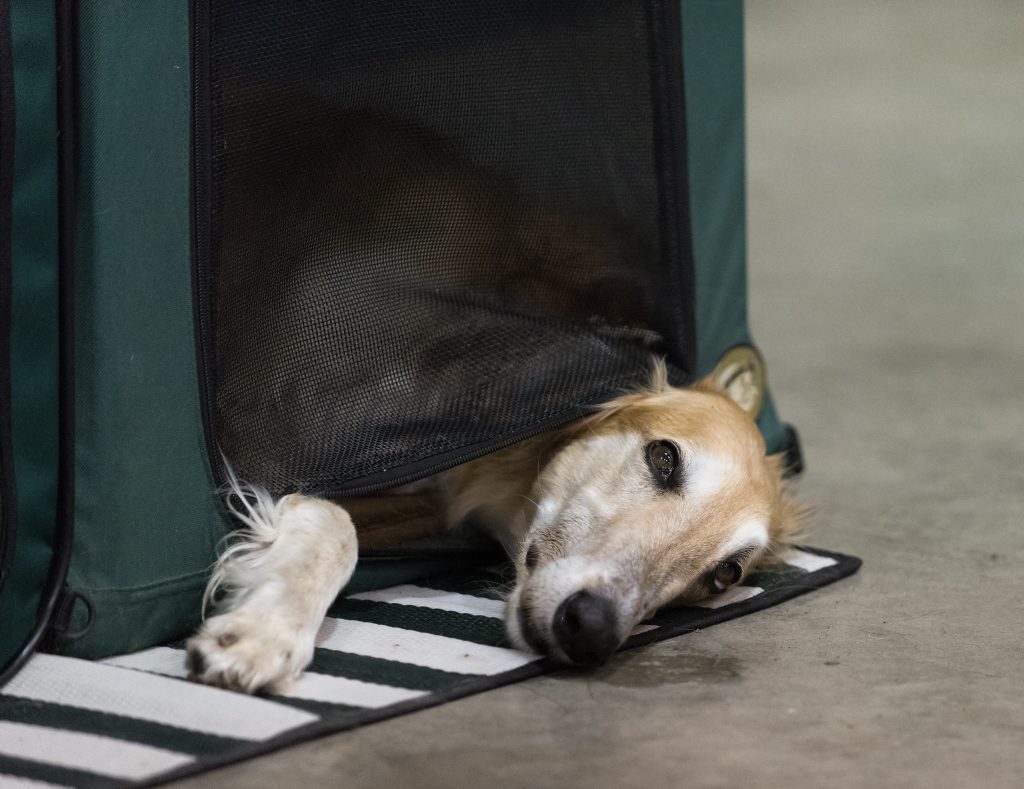It’s the unglamorous reality of agility trials: our dogs will inevitably spend quite a bit of time in a crate. I say crate, though it could also be an x-pen, a tent, or a car. But whichever flavor you choose, your dog will be confined for the bulk of the show. So it only makes sense that our dogs are comfortable with confinement and understand what they should be doing when they are in there.
Though I am only several years into the sport, it didn’t take me long to notice that a lot of dogs do not handle confinement well at agility trials (and classes too). My own dog was one of these, though it took me a while to realize it.
Here are some of the common crate behaviors at trials:
- Barking for extended periods of time.
- Whining until their owner returns.
- Destroying bed or blanket inside the crate.
- Barking and lunging at other dogs from within their crate.
- Trying to escape the crate.
- Refusing to go back in the crate after their run.
- Shutting down while in the crate due to stress.
If we don’t want our dogs doing these things, what DO we want them doing?
- Relaxing
- Resting
- Sleeping
- Chilling out

And why do we care about what they’re doing while crated? Two main reasons:
Optimal Performance
We want to give our dogs the best chance to be successful at a trial. Show fees are not cheap. And you’ve probably put in a lot of time training and sharpening all the skills you and your dog need while on course. If your dog is unsettled in their crate for hours before and between your runs – barking, lunging, whining, shifting around, or worrying – they are not going to be in the best mental state when it’s game time. If they’ve been calmly chilling out and napping, they aren’t going to be tired or frenzied or stressed when you do get them out of the crate, and thus much more physically and mentally ready.
Trial Environment
A frantic, loud dog creates environmental stress for all humans and dogs at the trial. If your dog is making noise, chances are that’s triggering other dogs in the vicinity to bark and whine too. And even if your dog isn’t joining in, the noise is disruptive and stressful for all dogs within ear-shot, making it harder for everyone to relax. I know there will always be barking dogs at agility trials. I think it’s more than okay for dogs to express themselves when they’re warming up and running the course. But just imagine how different the vibe of the crating area could be if all the dogs were relaxing and sleeping during their downtime.
A sea of sleeping, crated dogs just isn’t the norm though. Why is that?
Challenging Environment
Helping your puppy or dog learn to chill out in their crate can be hard enough at home, where things are familiar. Some dogs can really struggle with the concept and no dog comes programmed to automatically understand crates are for sleeping. Now add in a bunch of other strange dogs in close proximity, people walking every which way, barking, howling and whining, the anticipation of your turn, toys and treats all over the place and general trial buzz. All of that environmental stimulation can make settling in and napping a lot more challenging for our dogs.
Lack of Training
Without some training, it’s not really fair to expect our dogs to rest in their crate at a trial. Especially the kinds of dogs people choose for agility. We like them to be energized and excited and fast. If we never teach them that the crate is for chilling out and sleeping, they are more likely to choose other ways of behaving while crated in the trial environment.
So how can we help our dogs do more relaxing while they’re confined?
Consider how your dog copes with the environmental stress of a trial.
Every dog is an individual and some can handle more stimulation than others. Some are more sensitive and will be worn down by the hustle and bustle of the show. For those dogs, perhaps waiting in the car might be more comfortable for them. With the action further away, it may be easier for them to settle in and nap. My own dog, Ruby, does much better hanging out in the car than being crated indoors as the environment tends to wear her out. Or perhaps you make a plan so you don’t arrive as early and you leave immediately after your last run, to minimize the amount of time they spend in the trial environment. Maybe you even enter fewer runs than you would like to because your dog does better spending less time around all the show buzz. 
Make Sleep Easy
How can you set up your dog up to make the desired behavior more likely? These can be easy little tweaks like covering the crate with a blanket, choosing a crate location in a lower traffic area or putting a super comfy bed inside the crate. It could mean thinking ahead and providing enough exercise or enrichment for your dog so they feel able to relax. Regulating the temperature may also help your dog feel more comfortable. Again, every dog is unique, so think about what could set up your dog for relaxation.
Embrace Training
Even if you’ve moved your dog to the car and created an ideal resting space, it’s likely you still may need some training to help your dog choose to chill out while confined. Just like all good training, approximations are key; break things down in small steps for the dog. But unlike a lot of training, use of rewards can often create a new set of problems for a lot of dogs. We want our dogs resting, not thinking about how they can get more cookies from us. Desensitization is our friend here. Basically, exposing our dogs to crating in durations/environments/locations in which they feel safe and are able to relax and then gradually changing those variables at a pace in which the dog is successful. I think treats can be a great way of introducing a puppy/dog to a crate, but eventually our dogs need to learn that crate means rest time and not treat time.
Think about what aspects of calm confinement are hard for your dog. Is it being away from you for more than two minutes? Is it that other dogs are walking by the crate? Certain noises like the bang of the teeter? Then slice it into small steps so that your dog is successful at each point throughout the process. Maybe you start with your dog in a crate while you train your other dog. Then you bring your dog to work on crating while a friend trains in the ring. Perhaps your instructor will let you come to another class where you can focus solely on crating. Maybe you attend some fun runs and just practice crate skills. This way you’re gradually layering on the aspects that make the trial environment a challenge and building a history of your dog relaxing in their crate. If we make things too hard too fast, that behavior history won’t be as strong.
Take a Break
It’s really hard to improve a dog’s crate behavior within the environment that’s making them frenzied or stressed. If you work on crating at home and in class, but then still enter the trial where the dog is forced to be crated beyond what they are comfortable with, your training efforts will not be effective. It may be necessary to take some time off from competing. I know that can be discouraging, but consider how your dog’s performance in the ring can be positively enhanced when they’re able to feel safe and relaxed while waiting.
My Current Confinement Situation
I am always open to changing the confinement setup, but currently, this is the best arrangement for Ruby for both class and trials. I put her on the middle seat of my van. If the weather is cold, I make sure to have cozy blankets for her to make a nest. I’ll also likely be running the heat off and on. If it’s hot out, I’ll be running the air conditioning. She is able to rest and fall asleep easily on the middle seat, so I don’t find a crate necessary. I can also sit back there with her and give her pets, which she finds very relaxing.
After her runs, I take her on a walk and let her sniff as much as she wants. Then I give her a kong with a small amount of peanut butter inside the van. I’ve observed that licking helps her relax, which is true for many dogs, and I think it helps her come down from the hype of a run and transition into resting.
If your dog is struggling with the concept of “crate = chill time” in general, here are some helpful resources:
Crate Training A to Z E-book co-authored by me and Kayla Fratt (Certified Dog Behavior Consultant)
“Happy Crating” podcast from CogDog Radio
“Happy Crating” course by Sarah Stremming at Fenzi Pet Professionals Program
“Crate Expectations” blog series by Chrissi Schranz
Consider how much time our dogs spend confined as a part of agility AND how much their time in the crate affects their performance. It’s a win-win for both dog and handler to make calm crating a priority.
Did you realize how much your dog would need to be crated when you got into dog sports? What’s your confinement setup?





